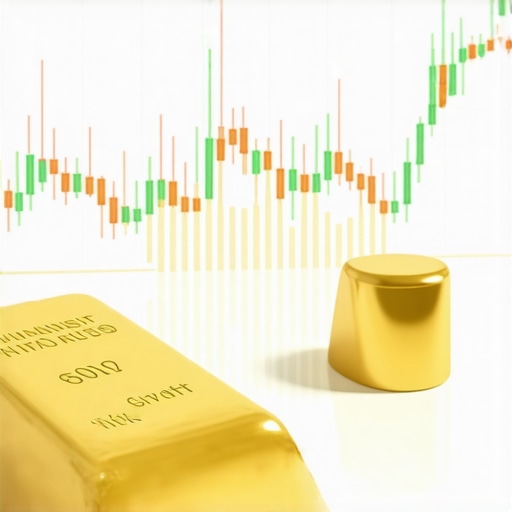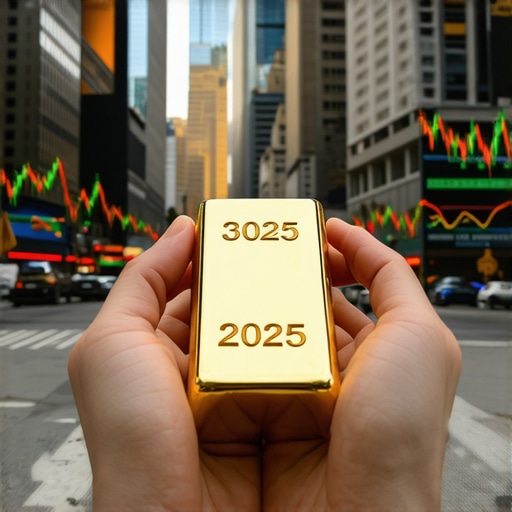Understanding Inflation and Its Impact on Investments
Inflation is a crucial economic concept that affects the purchasing power of money. When inflation rises, the value of currency declines, leading to increased prices for goods and services. This economic phenomenon can significantly impact investors’ portfolios, prompting them to seek reliable hedges against inflation. One of the most time-tested assets for this purpose is gold. This article explores the role of gold in hedging against inflation and why it remains a popular choice among investors.
Why Gold is Considered a Safe Haven Asset
Gold has been recognized as a safe haven asset for centuries, particularly during times of economic uncertainty and inflationary pressures. Unlike fiat currencies, which can be devalued by government policies or economic instability, gold maintains intrinsic value. Its scarcity, combined with the high demand for jewelry, electronics, and investment purposes, contributes to its price stability over the long term.
Many investors turn to gold during inflationary periods as it tends to appreciate in value when the cost of living rises. For example, analysis of historical data shows that gold prices often correlate positively with inflation rates. This trend occurs because as the value of currency diminishes, investors flock to gold as a tangible asset that preserves wealth. This behavior is reflected in the Gold Market Analysis: Current Trends and Future Predictions, which outlines how gold prices respond to inflationary pressures.
The Mechanism of Gold as an Inflation Hedge
The relationship between gold and inflation can be attributed to several key factors:
- Supply and Demand Dynamics: Gold mining is a resource-intensive process, and new supply is limited. As demand for gold increases, especially during inflationary periods, prices tend to rise accordingly.
- Currency Depreciation: As central banks print more money to stimulate economies during inflationary times, the value of paper currency declines. Investors often seek gold to mitigate this risk, driving up its price.
- Global Economic Stability: In times of geopolitical uncertainty or financial crises, gold serves as a universal currency, maintaining its value across borders, unlike most currencies that may fluctuate wildly.
Investors looking to safeguard their wealth often consider gold as a hedge against not just inflation, but also economic downturns. By incorporating gold into a diversified investment portfolio, individuals can enhance their financial security and mitigate risks associated with inflation.
Investing in Gold: Strategies and Considerations
For those interested in leveraging gold as a hedge against inflation, there are several investment avenues to consider. These include:
- Physical Gold: Buying gold coins or bullion is a direct way to invest in this precious metal. This method is tangible and allows for easy storage, although it comes with considerations for security and insurance.
- Gold ETFs: Exchange-Traded Funds that focus on gold can provide a more accessible and liquid option for investors. These funds typically track the price of gold and can be traded like stocks.
- Gold Mining Stocks: Investing in companies that mine gold can also serve as a hedge against inflation, as their profits often increase with rising gold prices.
In conclusion, understanding the role of gold in hedging against inflation can empower investors to make informed decisions. By incorporating this precious metal into their investment strategies, individuals can protect their wealth from the erosive effects of inflation and economic uncertainty. For further insights, consider exploring the Gold Investment: A Comprehensive Guide to Buying Gold.
Exploring Different Gold Investment Vehicles
When considering gold as a hedge against inflation, investors have several options to choose from. Each investment vehicle offers unique benefits and risks, catering to different investment strategies and preferences.
Physical Gold: Coins and Bullion
Purchasing physical gold in the form of coins or bullion is one of the most traditional methods of investing in gold. This tangible asset provides a sense of security, as it can be stored personally. However, it is essential to consider the associated costs, such as security and insurance. For more guidance on acquiring physical gold, check out our post on How to Buy Gold Coins: A Complete Guide for Investors.
Gold Exchange-Traded Funds (ETFs)
Gold ETFs offer a more accessible means of investing in gold without the need for physical storage. These funds typically track the price of gold and can be traded on stock exchanges like regular stocks. They provide liquidity and ease of transaction, making them a popular choice for many investors. For those unsure if gold ETFs are the right fit, our article on Investing in Gold ETFs: Are They Right for You? can offer valuable insights.
Gold Mining Stocks: An Alternative Approach
Investing in gold mining stocks represents another strategy to gain exposure to gold. As gold prices rise, so too do the profits of mining companies, potentially leading to increased stock values. However, investing in individual mining stocks can also introduce additional risks related to the mining industry itself. For a deeper understanding of this sector, consider reading our guide on Understanding Gold Mining Stocks: Risks & Rewards.
The Importance of Diversification in Gold Investments
Diversifying your investment portfolio is crucial, especially when including gold. By spreading investments across different gold vehicles—such as physical gold, ETFs, and mining stocks—investors can reduce risk while maximizing potential returns. This strategy helps balance the portfolio against market volatility and inflation.
Combining Gold with Other Assets
Incorporating gold into a broader investment strategy can enhance overall portfolio performance. For example, gold vs. stocks is a common debate among investors. Historical data suggests that gold may perform well during market downturns, while stocks may offer growth during economic expansions. For those interested in this comparison, our article Gold vs. Stocks in 2024: Which Investment Reigns? provides a comprehensive analysis.
Long-Term vs. Short-Term Gold Investments
Determining whether to invest in gold for the long term or short term is another critical consideration. Long-term investors often benefit from the historical appreciation of gold, particularly during economic uncertainty. In contrast, short-term traders may focus on market fluctuations and technical analysis. For strategies tailored to different investment timelines, refer to our post on Top Gold Trading Strategies to Maximize Your Invests.
Staying Informed About Gold Market Trends
To make informed decisions regarding gold investments, it’s essential to stay updated on current market trends. Factors such as inflation rates, central bank policies, and global economic events can significantly impact gold prices. Understanding these dynamics is vital for optimizing your investment strategy.
In conclusion, leveraging gold as a hedge against inflation involves exploring various investment vehicles and strategies. By diversifying your approach and staying informed, you can enhance your financial security and effectively navigate the complexities of the gold market. For further insights, visit our comprehensive guide on Gold Investment: A Comprehensive Guide to Buying Gold.
Understanding Gold Demand Trends: Key Influences
The dynamics of gold demand are complex and influenced by various factors. Understanding what drives gold prices upward is crucial for investors seeking to make informed decisions. Key elements include economic stability, geopolitical tensions, and shifts in consumer behavior.
Impact of Economic Stability on Gold Demand
Gold is often viewed as a safe-haven asset during times of economic instability. When economies face downturns, investors flock to gold to preserve their wealth. As a result, demand increases, driving prices higher. For instance, during the COVID-19 pandemic, gold prices surged as uncertainty prevailed. To gain deeper insights, explore our article on Gold Demand Trends: How They Affect Your Investments.
Geopolitical Factors and Gold Prices
Geopolitical tensions, such as conflicts or trade wars, can significantly impact gold demand. Investors often turn to gold as a hedge against potential crises. For example, the rising tensions in different regions can lead to increased buying activity, pushing gold prices upward. Keeping informed about global events can help investors anticipate changes in demand. For a detailed analysis of how these events shape pricing, refer to our post on Analyzing the Impact of Global Events on Gold Prices.
Consumer Behavior and Its Effect on Gold Demand
Shifts in consumer preferences can also influence gold prices. For instance, an increase in jewelry demand, particularly in emerging markets like India and China, can drive prices upward. Cultural significance attached to gold in these regions often elevates its demand. Understanding such trends allows investors to make predictions about future price movements.
The Role of Central Banks in Gold Demand
Central banks play a pivotal role in shaping gold demand. Their purchasing strategies can influence global prices significantly. When central banks buy gold to diversify their reserves, it creates upward pressure on prices. In recent years, many central banks have increased their gold purchases, reflecting a broader trend of using gold as a strategic asset. For insights into how central bank activities affect the market, check out our article on Central Bank Gold Purchases: Implications for You.
Investment Trends in Gold
Another aspect to consider is how investment trends can impact gold demand. The rise of gold-backed financial products, such as ETFs and mutual funds, has made it easier for investors to gain exposure to gold. Increased participation in gold investment products can enhance demand, consequently affecting prices. For detailed strategies on investing in gold, refer to our guide on Gold Investment Basics: A Guide for New Investors.
Future Trends in Gold Demand: What Investors Should Know
Looking ahead, it is essential to monitor how changing economic conditions and consumer behavior will shape gold demand. Emerging trends such as sustainable investing may also play a role in influencing future gold prices. Investors should stay informed about these developments to make strategic decisions. For a comprehensive overview of upcoming trends, visit our article on Future Trends in Gold Demand: What Investors Should Know.
In summary, understanding the various factors that drive gold demand trends is vital for investors. By keeping abreast of economic conditions, geopolitical events, and consumer preferences, investors can better navigate the gold market and optimize their investment strategies. For more insights on market trends, check out our page on Gold Market Analysis: Current Trends and Future Predictions.
Understanding Gold Price Fluctuations: An Overview
Gold prices are subject to various fluctuations influenced by multiple factors. Investors must understand these key influences to navigate the gold market effectively. Seasonal demand, economic indicators, and market speculations are just a few elements that can lead to price volatility in gold.
Seasonal Demand Patterns for Gold
Gold demand often follows seasonal trends, particularly in markets where gold jewelry is traditionally purchased during festivals or weddings. For instance, in India, demand typically increases ahead of major festivals like Diwali. Such seasonal spikes can lead to temporary price increases. To learn more about how these trends can affect your investments, explore our article on Gold Demand Trends: What Drives Prices Upward?.
Economic Indicators Affecting Gold Prices
Several economic indicators, such as inflation rates, interest rates, and employment figures, can significantly impact gold prices. For example, rising inflation often leads to increased gold demand as investors look for a hedge against eroding purchasing power. Monitoring these indicators can provide valuable insights into potential price movements. For a deeper understanding of how economic factors influence gold, check our article on How Gold Prices are Affected by Global Economic Trends.
Market Speculations and Their Impact on Gold Prices
Investor sentiment plays a crucial role in determining gold prices. Market speculations, driven by news and global events, can lead to sudden price shifts. For instance, if investors anticipate a financial crisis, they may rush to buy gold, causing prices to climb rapidly. Understanding market psychology is essential for making informed investment decisions. To gain further insights, read our post on Gold Trading Techniques: Mastering Market Movements.
Technical Analysis for Gold Investors
Utilizing technical analysis is a valuable strategy for predicting gold price movements. By studying historical price charts and identifying patterns, investors can make educated decisions based on market trends. Technical analysis can help identify key support and resistance levels, guiding when to enter or exit a trade. For a practical guide on using technical analysis, check out our article on Understanding Gold Trading Basics: A Beginner’s Guide.
Conclusion: Navigating the Gold Market
In conclusion, understanding the factors influencing gold demand and price fluctuations is vital for successful investing. By analyzing economic conditions, consumer behavior, and market speculation, investors can make informed decisions in the ever-changing gold market. For further insights, visit our comprehensive guide on Gold Investment: A Comprehensive Guide to Buying Gold.
Factors Influencing Gold Price Stability
While gold is known for its volatility, certain factors contribute to its price stability. Understanding these elements can help investors mitigate risks associated with price fluctuations. Global economic stability, currency strength, and geopolitical events can all play a role in maintaining a steadier gold price.
Global Economic Stability
When the global economy is stable, gold prices tend to hold steady. Investors are less likely to seek gold as a safe haven during times of economic growth, which can lead to reduced demand and stable prices. Conversely, economic instability often drives investors back to gold, causing fluctuations.
Currency Strength and Its Effect on Gold Prices
The strength of the US dollar is inversely related to gold prices. When the dollar is strong, gold prices typically decrease as it becomes more expensive for foreign buyers. Conversely, a weaker dollar can lead to increased demand for gold, driving prices up. Monitoring currency trends is essential for gold investors.
Understanding Geopolitical Risks and Gold Investment
Geopolitical events, such as conflicts or political instability, can create uncertainty in financial markets, leading to increased gold prices. Investors often flock to gold during times of unrest, viewing it as a safe-haven asset. Staying informed about international relations and political developments can provide insight into potential gold price movements.
Long-term vs. Short-term Gold Investment Strategies
Investors must decide whether they prefer long-term or short-term strategies when investing in gold. Long-term investors often hold gold as a hedge against inflation and economic downturns, while short-term traders may capitalize on price fluctuations. Each strategy has its advantages and risks, depending on market conditions.
Frequently Asked Questions About Gold Prices
What drives gold prices up?
Gold prices are driven up by factors such as increased demand during economic uncertainty, rising inflation, and geopolitical tensions. Investors often turn to gold as a safe-haven asset during these times.
How do interest rates affect gold prices?
Interest rates have an inverse relationship with gold prices. When interest rates rise, gold prices often fall as investors seek higher returns from interest-bearing investments. Conversely, when rates are low, gold becomes more attractive.
Is gold a good investment during inflation?
Yes, gold is often considered a good investment during inflationary periods, as it typically retains its value and can act as a hedge against the eroding purchasing power of currency.
How can I invest in gold?
Investors can invest in gold through various methods, including purchasing physical gold, investing in gold ETFs, or buying shares in gold mining companies. Each method has its own risks and benefits.
What are the risks of investing in gold?
The risks of investing in gold include market volatility, changes in demand, and geopolitical factors. Additionally, storage and insurance costs for physical gold can add to the overall investment risk.
How does gold compare to other investments?
Gold is often seen as a stable investment compared to stocks and bonds. While it may not provide the same level of returns during bullish markets, it can offer protection during economic downturns.
What is the best time to buy gold?
The best time to buy gold can vary, but many investors consider purchasing during market dips or periods of economic uncertainty to capitalize on lower prices.
How frequently do gold prices change?
Gold prices can change frequently due to market dynamics, geopolitical events, and economic indicators. Prices can fluctuate daily, making it essential for investors to stay informed.
Where can I find reliable gold price information?
Reliable gold price information can be found on financial news websites, market analysis platforms, and through financial advisors. Keeping an eye on reputable sources is crucial for accurate data.
Conclusion: Mastering Gold Investment Strategies
In summary, understanding the various factors influencing gold prices—from seasonal demand and economic indicators to geopolitical risks—equips investors with the knowledge needed to navigate the gold market effectively. By employing both long-term and short-term strategies and staying informed through reliable resources, investors can enhance their ability to make sound investment decisions in the dynamic realm of gold trading.










